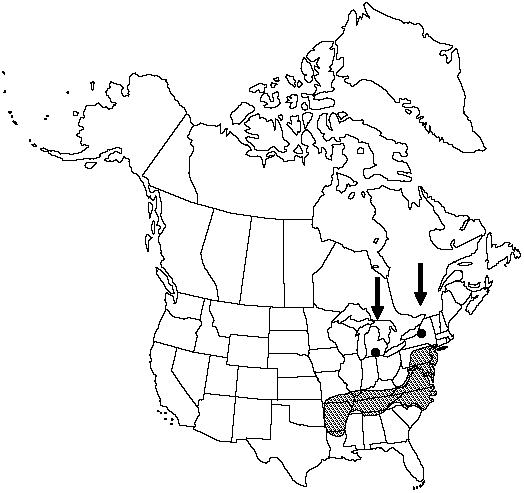Difference between revisions of "Dryopteris celsa"
W. Palmer, & Pollard, Proc. Biol. Soc. Wash. 13: 202. 1900.
imported>Volume Importer |
RevisionBot (talk | contribs) m (Bot: Adding category Revised Since Print) |
||
| Line 60: | Line 60: | ||
}}<!-- | }}<!-- | ||
| − | -->[[Category:Treatment]][[Category:Dryopteris]] | + | --> |
| + | |||
| + | [[Category:Treatment]] | ||
| + | [[Category:Dryopteris]] | ||
| + | [[Category:Revised Since Print]] | ||
Latest revision as of 19:38, 6 November 2020
Leaves monomorphic, dying back in winter, 65–120 × 15–30 cm. Petiole 1/3 length of leaf, scaly at least at base; scales scattered, dark brown or tan with dark central stripe. Blade green, ovate-lanceolate, gradually tapering to tip, pinnate-pinnatifid, herbaceous, not glandular. Pinnae ± in plane of blade, lanceolate-ovate; basal pinnae linear-oblong, much reduced, basal pinnules longer than adjacent pinnules, basal basiscopic pinnule and basal acroscopic pinnule equal; pinnule margins crenately toothed. Sori midway between midvein and margin of segments. Indusia lacking glands. 2n = 164.
Habitat: Seepage slopes, hammocks and logs in swamps, mostly on the Piedmont and Coastal Plain
Elevation: 50–800 m
Distribution

Ala., Ark., Del., Ga., Ill., Ky., La., Md., Mich., Mo., N.J., N.Y., N.C., Pa., S.C., Tenn., Va., W.Va.
Discussion
Dryopteris celsa is a fertile allotetraploid derived from hybridization between D. goldieana and D. ludoviciana. Dryopteris celsa hybridizes with six species; hybrids can usually be identified by the dark-striped scales.
Selected References
None.